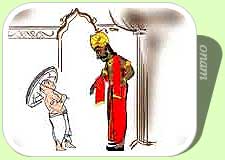Brief Sketch of King MahabaliIt may be noted Mahabali was the son of Veerochana and grandson of Prahlad, the devout son of demon King Hiranyakashyap. Mahabali had a son called Bana, who became a legendary king in his own right and became popular as Banraj in central Assam. Mahabali belonged to the Asura (demon) dynasty but was an ardent worshiper of Lord Vishnu. His bravery and strength of character earned him the title of
"Mahabali Chakravathy" or Mahabali - the King of Kings.
Challenge for GodsLooking at the growing popularity and fame of King Mahabali Gods became extremely concerned and jealous. They felt threatened about their own supremacy and began to think of a strategy to get rid of the dilemma.
To curb the growing reign of Mahabali and maintain their own supremacy,
Aditi, the mother of Gods seeked help of Lord Vishnu (the preserver in the Hindu trinity) whom Mahabali worshiped.
It was said Mahabali was very generous and charitable. Whenever anybody approached him for help or requested for anything he always granted. To test the King, Lord Vishnu disguised himself as a dwarf and a poor Brahmin called
Vamana. He came to the Kingdom of Mahabali, just after Mahabali performed his morning prayers and was preparing to grant boons to Brahmins.
 Lord Vishnu takes Vamana Avatar
Lord Vishnu takes Vamana AvatarDisguised as Vamana, Vishnu said he was a poor Brahmin and asked for a piece of land. The generous King said, he could have as much land as he wanted. The Brahmin said that he just wanted as much land as could be covered by his
three steps. The King was surprised to hear but agreed.
A learned adviser of the King,
Shukracharya sensed that Vamana was not an ordinary person and warned the King against making the promise. But, the generous King replied that it would be a sin for a King to back on his words and asked the Brahmin to take the land. The King could not imagine that the dwarf Brahmin was Lord Vishnu himself.
Just as King Mahabali agreed to grant the land, Vamana began to expand and eventually increased himself to the size of cosmic proportions. With his first step the Brahmin boy covered the whole of earth and with the other step he covered the whole of the skies. He then asked King Mahabali where is the space for him to keep his third foot.
The King realised that he was no ordinary Brahmin and his third step will destroy the earth. Mahabali with folded hands bowed before Vamana and asked him to place his last step on his head so that he could keep the promise. The Brahmin placed his foot on the head of the King, which pushed him to
patala, the nether world. There the King requested the Brahmin to reveal his true identity. Lord Vishnu then appeared before the King in his person. The Lord told the King that he came to test him and the King won the test. King Mahabali was pleased to see his lord. Lord Vishnu also granted a boon to the King.
King Mahabali Requests for a Visit to KeralaThe King was so much attached with his Kingdom and people that he requested that he be allowed to visit Kerala once in a year. Lord Vishnu was moved by the Kings nobility and was pleased to grant the wish. He also blessed the King and said even after losing all his worldly possessions, the King would always be loved by Lord Vishnu and his people.
Genesis of OnamIt is the day of the visit of King Mahabali to Kerala that is celebrated as Onam every year. The festival is celebrated as a tribute to the sacrifice of King Mahabali. Every year people make elaborate preparations to welcome their King whom they affectionately call Onathappan. They wish to please the spirit of their King by depicting that his people are happy and wish him well. The second day,
Thiruvonam is the biggest and the most important day of this festival. It is believed that King Mahabali visits his people on the second day.
Onam celebrations are marked in
Trikkakara, a place 10 km from Kochi (Cochin) on the Edapally- Pookattupadi road. Trikkara is said to be the capital of the mighty King Mahabali. A temple with a deity of
'Trikkakara Appan' or
'Vamanamurthy' who is Lord Vishnu himself in disguise is also located at this place. Nowhere else in Kerala can one find a deity of 'Vamanamurthy'. This fascinating legend is artistically depicted at the Suchindram Temple in Kanyakumari district of Tamil Nadu.

















